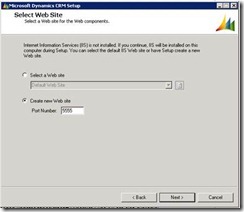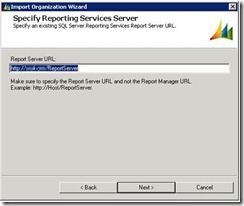Find a blog post to detail precedues of upgrading crm4.0 to crm2011. So mark it for reference which maybe
be referred in the future for some projects. Yes, i think it is a good experience in mind before project will be implemented.
http://weblogs.asp.net/pabloperalta/archive/2010/11/01/step-by-step-installing-crm-2011-on-premise-and-migrating-from-dynamics-crm-4-0-32-bits-on-premise.aspx
Step by step: Installing CRM 2011 On-premise and Migrating from Dynamics CRM 4.0 (32 bits, on-premise).
Hi,
I have been experimenting a little bit installing Dynamics CRM 2011 and in particular, migrating from a CRM 4.0 32 bits deployment and decided to share it with here the community, specially to show youhow simple is the overall process.
Obviously there are complete guides downloadable here by Microsoft but they are sometimes not the best reference when you want to have arapid and visual overview of the process, specially, about the most typical / simple case. Meaning a case where you have an existing on-premise organization with data + entities customizations and workflows.
So, I focused here on copy and pasting screenshots of a migration like that, including some brief comments and in case you need more details, I suggest you refer to installation guide.
Let's start. First of all..
Installing CRM 2011
In this case, I run SQL Server, Reporting Services and Dynamics CRM 2011 Server on the same box.
So, the step by step process was:
1. Fulfill pre-requisites by installing SQL Server 2008 / 2008R2 64 bits with SSRS. In my case this was on top of a Windows Server 2008 R2 64-bits machine.
(I am assuming you already have an Active Directory domain and the server is member of it. Also, you are administrator on local machine, domain admin or have the corresponding privileges to create new security groups in AD)
2. Start Dynamics CRM Installation by double-clicking SetupServer.exe located in Server\amd64 folder.
3. Enter the product key. For beta, use the following product keys :
· Microsoft Dynamics CRM Workgroup (5 CAL limit): FF2JM-QX9PG-HXT8M-MMHXG-4MF32
· Microsoft Dynamics CRM Server (no CAL limit): 4FDTK-3HYV2-D9CCJ-4MF9Q-QJ32X
Important
Although the application may display a 90-day trial period, these trial product keys will expire after 270 days.
Microsoft Dynamics CRM Professional edition is no longer available with Microsoft Dynamics CRM 2011.
· Accept license agreement:
5. Click on 'Install' to automatically install required components.
6. Choose the installation directory:
7. Choose the server roles. In a simple, typical installation you may leave this as default ('Full Server' option) which installs all the server roles on your Dynamics CRM Server.
8. Indicate the SQL Server where you want to install Dynamics CRM databases.
You can choose between a new deployment or to upgrade an existing deployment.
Remember upgrading could be done in place in case we are talking about a CRM 4.0 64 bits installation on top of SQL Server 2008 64 bits. As we are covering here the CRM 4.0 32-bits scenario, we are going to select 'Create new deployment' and after installation, we are going to import the existing CRM 4.0 32-bits organization.
9. Select the location where you want the Microsoft Dynamics CRM organizational unit to be installed into. Microsoft Dynamics CRM security groups are created in this organizational unit.
10. Specify the account to be used to run Dynamics CRM Services.
It's recommended that you use an account with low privileges, dedicated to run this services (it must a member of the Performance Log Users security group).
In this case, I just selected built-in Network service account.
11. Next step, if IIS is not installed, setup will install it as part of the installation and what we need to specify is the website where CRM Web Front-end will be installed.
As a best practice, you would like to create a new separate website for this case and that's in fact the option I chose.
12. If you plan to install e-mail Router component, enter here the name of the computer where you are going to install it. This computer will be used to route Microsoft Dynamics CRM e-mail messages. If you will not install the E-mail Router you can leave this box blank.
In this case, I just left it blank
13. Specify the organization settings (name, base currency)
14. In the Next step, you must choose the reporting services server URL.
15. On next step you just choose if you want to participate on the customer experience program or not.
16. Next step is a great news from CRM 2011 and lets you use Microsoft Update to automatically check for updates for your Dynamics CRM components.
Clearly, choosing this option is the recommended practice.
17. On next step the setup performs a system verification:
If everything is right, setup allows to continue. If not, you may need to troubleshoot identified issues first.
18. Going on with the installation, the next steps is just informative about the services that may have to be stopped or
restarted during the setup.
19. Ready to install! This step displays a summary of all the parameters entered for installation.
20. By clicking on 'Install' , setup will start copying and installing files:
21. When finished, you may see a window similar to the following one:
22. If the Reporting Server instance that you specified during this Setup points to the local computer where Microsoft Dynamics CRM is installed, Setup provides an option to invokeMicrosoft Dynamics CRM Reporting Extensions Setup.
You must install the Microsoft Dynamics CRM Reporting Extensions to create, run, and schedule reports in Microsoft Dynamics CRM and it has to be installed on same machine SQL Server Reporting Services is installed.
In my case, as everything is on the same box, I checked on the option in order to install the extensions:
23. At this point we can see that Windows Update jump into scene in order to check if there is any update available before installing CRM Reporting Extensions.
If you choose 'Get updates for Microsoft Dynamics CRM (recommended)' and click on 'Next', setup will check for updates and in case there isn't any, the following dialog may appear:
24. By clicking on 'Next', Dynamics CRM Reporting Extensions files start to be copied:
25. Accept the agreement.
26. Specify the SQL server that stores the CRM Config database.
In this case, as it's everything on the same box, this points the same server.
27. Specify the SSRS instance. Probably you will just accept the default values.
28. Select the installation location
29. By clicking 'Next', the System Checks start. At the end you should a dialog similar to the following:
The warning in this case is because the CRM server and the SSRS Web site are installed on the same computer. Therefore, the CRMAppPool application pool and the ReportServer application pool are both running under the network service account.
In our environment, this is not a problem at all, so just go ahead.
30. Going on with the installation, the next steps is just informative about the services that may have to be stopped or
restarted during the setup.
31. Ready to install CRM Reporting Extensions!
32. When installation finishes, setup will display the following dialog:
At this point, we have CRM 2011 successfully installed!!.
You can try it and play a little bit if you want ![]() …
…
..now.. Let's go on by..
Upgrading from Dynamics CRM 4.0 32 bits.
33. Get a full backup of your current Organization SQL Server database on Dynamics CRM 4.0.
34. Restore the DB backup on the new SQL Server instance used for Dynamics CRM 2011.
35. Open Deployment Manager console (Start->All Programs->Microsoft Dynamics CRM->Deployment Manager)
36. Within Deployment Manager, go to Organizations->Import Organization…
37. Select the SQL Server instance and the Organization database to import. This corresponds to the restored DB on the SQL Server 2008/2008R2 instance used for Dynamics CRM 2011.
If everything is on the same box as this case, you may already have the values automatically inferred.
38. Then, the Import Organization Wizard will ask for some parameters regarding to the organization itself, such as the display name we want to use.
39. After setting the above parameters we will be asked about users mappings, this is,how the users which are present on the organization to be imported are mapped to CRM accounts.
If you are migrating from a Dynamics CRM 4.0 deployment which is on the same domain (as it is this case), you would prefer just to allow CRM 2011 to automatically map the users and create the new users as needed.
For doing so, just click on the first option and press 'Next'.
40. The result of the auto-mapping:
41. If the domain user account you are running the application is not mapped with any user with the System Administrator security role, you will be prompted with the following message:
This means you will have to manually map one of the accounts to the current user you are logged on. Do this by just selecting the user and clicking on 'Browse...' to specify the current user account.
42. On next step, some system checks are carried out again:
43. The 'Ready to Import' dialog comes up!. Just click on 'Import' to start the migration!.
44. The import runs (it takes some time, depending on the amount of data and customizations)...
45. When the import process finishes successfully, it displays the following message:
46. If you want to set this imported organization as your default one, just get back to Deployment Manager->Organizations , refresh data (if you had the app open while importing) and then right click the imported organization and select 'Set as Default Organization'
If you are not going to use the default organization created during the CRM 2011 installation, I would suggest to delete it, also by right-clicking on the organization name.
47. Now , just enter the URL on Internet Explorer and verify your data and customizations!:
At this point, you already installed CRM 2011 and successfully migrated an existing CRM 4.0 32-bits organization.
Note:
I could see that all the data and customizations have been successfully migrated.
Nevertheless, if your scenario includes ISV customizations (i.e. new .aspxs, javascripts, plugins code) I guess you may need to make some adjustments in order to make it work successfully on CRM 2011.













































